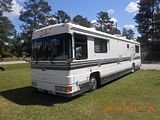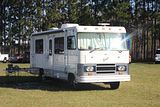Go to...  | Start A New Topic  | Search  | Notify  | Tools  | Reply To This Topic  |  |
I have recently purchased a 1987 28 ft Regency.Upon the test drive, the transmission temperature was about 300 degrees on load up a small grade.I'm wondering if this is acceptable temperature or not ? Also what would be envolved in maintenence and/or repair? This Rig has a 454 gas & Chevy frame. Thanks in advance for any advice. Gerry gmerritt@citlink.net | |||
|
"the transmission temperature was about 300 degrees on load up a small grade.I'm wondering if this is acceptable temperature or not ? Also what would be envolved in maintenence and/or repair?" My opinion: It should run engine temp (ca 180-200) cruising at 3,000-4000 rpm; 200-230 or so up hills perhaps, dropping quickly back down after the climb. 300 is way too high. 1) Does the fluid (on the stick) look burned, i.e. brown or ugly-dark-red? Does it smell "burned"? If so, it has been too hot and must be changed. 2) First thing, even if it appears okay: go to Pep Boys and buy a new filter & Dexron fluid. SHADETREE MECHANICS STOP READING! You have a Turbo400 trans -as opposed to a (passenger car) Turbo350- and it has no drain plug, so loosen about a dozen small bolts from around the outside flange of the xmiss pan, break the gasket seal with a small screwdriver between the flange and body, and tilt the pan to drain the fluid into the catch container you've placed underneath (splashing smelly fluid all over yourself). Remove all bolts, then remove the pan. The filter is a flat, thin aluminum-framed thing about 8X10", held up by one small bolt near the front. Remove the bolt, then the filter by pulling it down. A 1"dia tube extends from the front of the filter up into the trans; pull it down and out if it doesn't come off with the filter. Now (important): stick your finger up into the receiver hole the tube came out of and remove any O-rings left in there. The new filter will have a new O-ring for the upper tube neck to seal it, and often the old ring will remain in the cavity (in a 20-year old trans, maybe 2 or 3) when the tube is removed. Clean the flange face on the body and on the pan. Install the new tube with O-ring, then the filter by inserting the one bolt through it into the body; place the new neoprene gasket on the pan, held in place by a LIGHT coating of gasket sealer; hold the gasket in place by pushing bolts through the pan holes into the gasket while sealer dries; then place the pan on the body and screw in the bolts. Don't overtighten, as the body is aluminum. Fill with new Dexron, drive until operating temperature is reached and check fluid level. It's real easy to change fluid/filter - about like an oil change. Next: Your trans fluid circulates through the radiator. Probably has two stainless 1/4" lines entering and leaving the radiator on the rear face, on the passenger side, high and low. You may wish to unscrew them one at a time (carefully!), start the engine, and see if fluid is circulating. Sometimes one of these becomes crimped (usually up close to the trans where you can't get to it) and fluid circulates slowly or not at all. You can see both these lines from beneath the engine. If it heats up after this, I yield to more-knowledgeable Barthers. Good luck! "You are what you drive" - Clint Eastwood | ||||
|
 |
Are sure this isn't a Regal. I don't believe Barth ever built a Regency that wasn't diesel. Nick | |||
|
Correction, should be "regal". Thanks so much for the input, and info Gerry | ||||
|
| The Old Man and No Barth |
300 degrees is definitely too hot. I agree with Gunner's advice, & would also suggest you look to see if an aftermarket trans. cooler has been installed. It will be a finned device in front of the air conditioning condenser. One or both of the lines Gunner mentions for the built-in cooler in the radiator, will be attached to it. It may be installed in series with the built-in cooler, or may bypass it completely. If it isn't there, one of the first things you should do is go to your local auto parts supplier, buy one & install it according to the instructions that come with it. Furthermore, in any 20-year old vehicle, regardless of what service stickers may be on the vehicle, & regardless of what the previous owner may say, one of the wisest investments you can make is an engine oil & filter change, & drain, flush, & refill the radiator with new coolant. When you've completed all these steps, odds are your engine & trans. temps will be normal. One more possible problem is a faulty fan clutch, or a slipping belt. Either of those problems are usually reflected in high engine temps. Bottom line - do all these things & you'll know from the outset that your coach is properly serviced, & you can start from there to resolve any remaining problems. | |||
|
Glassnose Aficionado |
Gunner, "More Knowledgable Barthers" would be hard to come by. 79 Barth Classic | |||
|
 |
It may sound simple, but don't overlook that the gauge may be bad. We just had to replace the gauge on our 93 that was reading all over the place. New gauge reads about 160 cruising about 70 mph. Nick | |||
|
| First Month Member |
Where is the 300 degrees being measured? 300 is about the max you should see coming out of the converter, but is not unusual up a hill with a load on a hot day. 300 is too hot in the pan. How were your engine temps when the tranny was that hot? . 84 30T PeeThirty-Something, 502 powered | |||
|
| First Month Member |
Well? . 84 30T PeeThirty-Something, 502 powered | |||
|
| Powered by Social Strata |
| Please Wait. Your request is being processed... |
|
This website is dedicated to the Barth Custom Coach, their owners and those who admire this American made, quality crafted, motor coach.
We are committed to the history, preservation and restoration of the Barth Custom Coach.
We are committed to the history, preservation and restoration of the Barth Custom Coach.

